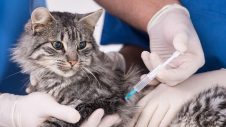What is Ringworm?
Ringworm is a fungal infection of the outer layers of the skin, hair and nails. In animals Microsporum sp. and Trichophyton sp. Are the most commonly seen. They are classified as geophilic (soil loving), zoophilic (animal loving) or anthrophilic (human loving).
Young animals as well as young children are more susceptible to infection.
What are the clinical signs of Ringworm?
- The ‘classic ringworm lesion’ is a rapidly expanding circular or irregular patch of inflammed, scaly skin with hair loss. This is most frequently observed in puppies, kittens and humans.
- Generalised Forms. Affects large parts of the body. The skin is often infected with bacteria and may have pustules and inflammed, swollen skin.
How is Ringworm diagnosed?
- Wood’s Lamp. When hairs infected with fungal spores are examined under an ultraviolet light (wood’s lamp) they often emit an applegreen fluorescence. Not all fungal infections will cause fluorescence.
- Direct examination of hairs under a microscope.
- Fungal culture. The fungal spores are grown in culture media in the clinic or at a pathology laboratory. Results from this test may take up to 3 weeks.
What is the treatment for Ringworm?
In both small and large animals, fungal skin infections are usually self-limiting with spontaneous remission occuring within 1-3 months. However, treatment is always indicated to minimise the risk of spread of infection to humans (particularly children) and to other cats and dogs.

 Greencross Vets
Greencross Vets 





